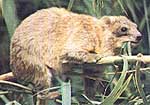TREE HYRAX

How to Recognize
Hyrax resemble a large, robust guinea pig. They aren't rodents but are actually distant cousins to the elephant! They both have toenails that are almost hooves, and some African tribes even call the hyraxes "little brothers of elephants."
There are three species – rock, bush, and tree (we only saw the tree hyrax). They have short ears and legs, and thick, soft fur that is gray-brown to black in color. The hyrax has a distinct patch of lighter colored hair on its back which covers a scent gland, and this patch of hair bristles when it's excited or mating.
Habitat
Tree hyraxes can be found in thick forests. Because of their inability to derive moisture from their food, they can't regulate their own body temperature. Therefore, hyrax must stay in or near shelter because prolonged exposure to heat or cold could be fatal.
Behavior
Nocturnal. These animals are very sociable, living in colonies of up to 60 animals. They are known for their very loud and piercing contact calls that are generally made after dark when the hyrax is leaving to forage.
Breeding
Hyraxes usually have litters of one or two after a gestation period of 6½ to 7½ months. The young can run and jump soon after birth, and they nurse for up to six months. Hyraxes often cooperate in caring for the young. While one adult tends to the offspring, the other adult feeds.
Feeding
Hyraxes eat grasses, buds, leaf stems, bark, and fruit. They have short feeding times, about an hour a day.
Enemies
A hyrax's enemies are leopards, eagles, foxes, weasels, and mongoose. To protect itself, the group will post a scout. If an enemy is coming, it will warn the others with a sharp bark.
TOP OF PAGE
Copyright © 2002, Dawn M. Dalton.
All rights reserved.
**LINKS**
WHERE?
WHY?
ITINERARY
PLAN YOUR TRIP
GETTING THERE
LONDON
KENYA
UGANDA
SAFETY
ITEMS BOUGHT
STAYING HEALTHY
COMMENTS
HOME
BHS HOME
---Animal Facts--
Baboon
Buffalo
Cheetah
Chimpanzee
Crocodile
Eland
Elephant
Gazelle
Giant Forest Hog
Giraffe
Gorilla
Hippopotamus
Hyena
Hyrax
Impala
Jackal
Lion
Mongoose
Monkey
Ostrich
Rhinoceros
Topi
Uganda Kob
Warthog
Waterbuck
Wildebeest
Zebra